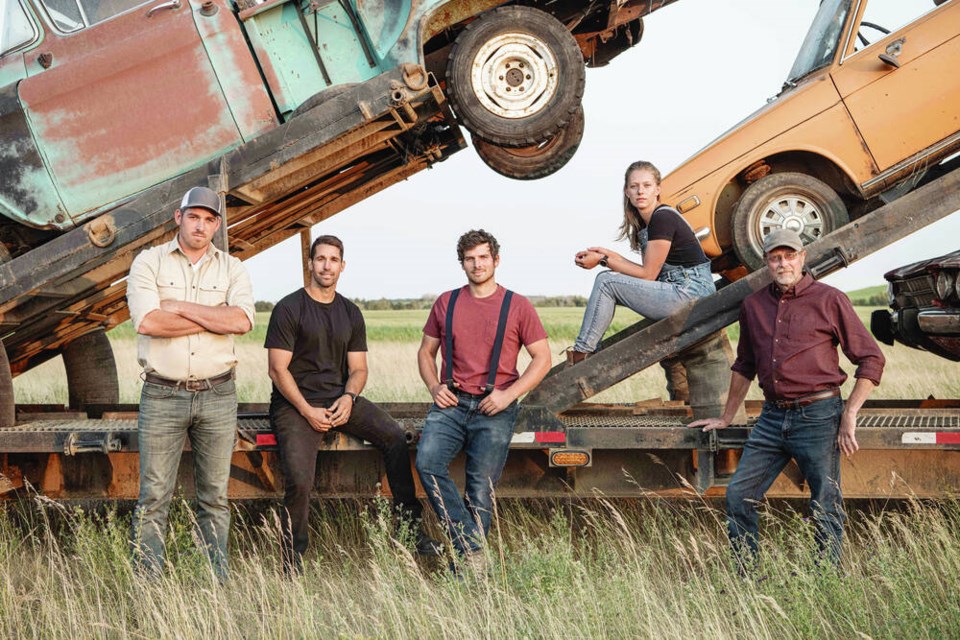Matt Sager of Mill Bay is a hunter, but not of the big-game variety. His specialty is cars and trucks — rusty, deteriorated ones that are abandoned and in need of rescue.
Sager finds these long-forgotten gems throughout remote areas of Western Canada, and saves them from abandoned barns, deep ravines and thick forests. It’s not simply the pursuit of these classic cars and trucks that makes what he calls his “extreme hobby” so interesting; equally impressive is the way in which they are located and extracted, with help from his team. And that exercise is what has Sager and Co. at the centre of Lost Car Rescue, a six-part series that premières tonight at 9 p.m. on History.
The easygoing team leader is joined on the series by a colourful cast: His brother, Steve Sager, who is the team’s mechanic; longtime friend Jessica James, who pilots the plane from which Matt locates the vehicles; Dave Mischuk, an autobody specialist who assesses the damage and cost of repair; and Lee Brandt, the crane operator whose mechanical arm plucks the vehicles from the jaws of Mother Nature.
What results is a combination of comedy, drama, educational programming and sheer entertainment. For Sager, it’s the best gig in the world. “Who wouldn’t want to fly around in a high-powered aircraft, low to the ground, and find what could be a $10,000 or $20,000 token in a ravine?”
The Sager brothers are both based in Mill Bay and make their living in the commercial construction industry (their family’s business, Richwood Contracting, has rebuilt much of the West Coast Trail for the province). They got into rescuing cars seven years ago and later added James, a longtime friend whom Matt met 10 years ago in flight school.
James recently moved from Chemainus to Vernon. Other members of the team are also spread out — Brandt is based in Langley, while Mischuk lives in Rabbit Lake, Sask. — but theirs is a business for which prep work can be done remotely and in advance, Sager said.
“We can only hunt for cars, realistically, two or three months a year because of the weather and high winds.” That limits their hunting season from March to May, “when the leaves aren’t on the trees and you can see through everything.”
Car hunting isn’t exactly a lucrative business, “but it does bankroll itself,” Sager said. “You don’t find the [rare] cars every time, so you’ve got to find cars that pay the bills.”
The working vehicles owned by Sager and used in the show have been found and restored by the team, from the 1988 Freightliner semi-truck that ferries their discoveries — customized with its own crane arm — to the 1948 Stinson 108 plane that serves as their eye in the sky. By this point, after nearly a decade in the game, there isn’t much they haven’t come across out on the road. Among their rare finds is a Volkswagen bus that travelled to the original Woodstock festival, and scores of muscle cars.
“In the last 10 years, between Dave and I and the majority of the team, it wouldn’t be crazy to say that we’ve found 8,000 or 9,000 cars.”
That doesn’t mean they all sold for huge amounts, Sager is quick to point out. “Value is a very broad term. I don’t really value cars for how much money they sell for, I value them by how much of a podium they are restored to. If they make it down to [U.S. auto auctioneers] Barrett-Jackson or in the Petersen Museum [in Los Angeles], that’s how I value them.”
Episodes of Lost Car Rescue are split between Peace River Country in B.C. and the bush of Northern Saskatchewan, areas whose remoteness can be problems if the vehicles and heavy equipment used to recover and transport the cars break down. Heaps of tools and spare parts, including more than a dozen tires, have to be brought along for the ride as these aren’t areas with service stations nearby, Sager said with a laugh.
“I’ve been on trips where I’ve blown four tires. And that could be a $2,000 tire if you’ve got to call someone to drive six hours to give it to you. There’s a lot of prep work before we leave.”
From the air, Sager said he can spot between 80 and 100 cars an hour, in high-volume locations. Inventory isn’t the problem, it’s finding the owners and convincing them to sell.
“The best cars are the ones that not even the owner knows about. And you think, how would an owner not know it’s there? Well, people in the Prairies own many [acres] of land, and that land has changed hands through generations. Many times we have found a barn that has a car in it, and owners have never even seen the barn. There could literally be anything in there. Or, it could be empty.”
The majority of cars are found through the air, which is an approach unique to this team. The remainder are found by word of mouth. Sager has a few rules-of-thumb he abides by when hunting for cars. The most effective? Follow the money.
“Where was the money back in the day that allowed people to buy great cars? Boom and bust towns. Gold towns. Somewhere when people had a lot of money, and then left one day.”
For a second season of Lost Car Rescue to be ordered, much has to be decided, almost all of which is beyond Sager’s control. Finding content — cars and trucks, in this particular case — won’t ever be the issue, however. “It’s the economy of scale. If you find that many cars, the hot ticket item — the rare one that everybody wants — is coming. That’s the exciting part of it. There’s no lack of cars. And the rare ones are still there.”
Lost Car Rescue airs Thursdays at 9 p.m. on History.


-thumb.png;w=120;h=80;mode=crop)
